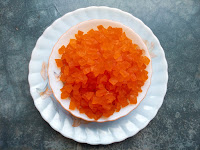Tutti frutti are bright coloured (red, green or yellow) sweet in taste, small cubical pieces made from raw papaya. These tutti frutti are used in cakes, cookies, ice cream and in desserts.
Tutti frutti can also be prepared from watermelon. The sweet red flesh part of watermelon is very popular but actually the whole part of watermelon is edible including its rind. Watermelon rind can be used for making tutti frutti. Peel and discard the green part from the watermelon rinds using a sharp knife. Then make small cubical pieces of it. Use any colour of your choice. Here I have used orange food colour and the final product is just awesome. Get the full recipe below :
Also try :
Easy Tutti Frutti Recipe Made From Watermelon
🔪Preparation Time : 30 minute
♨Cooking Time : 30 minutes
🕞Total : 1 hour
INGREDIENTS:
- 1 watermelon (1 kg weight)
- 2 cups of water
- 2 cups of sugar
- 2 cups of water (for syrup)
- Food colour (red, orange, green, yellow or any of your choice)
METHOD:
- Enjoy the red flesh part of the watermelon. Peel and discard it's green part. Make small cubes of its rinds.
- In a pan boil 2 cups of water. Add cubes of watermelon rinds and boil for 10 minutes or until the cubes look translucent.
- Drain and keep aside.
- Again boil 2 cups of water in a pan. Add 2 cups of sugar. Simmer until the syrup thicken.
- Add boiled watermelon rind cubes into the syrup and boil again for 10 minutes.
- Drain and keep it in a bowl. Add 2-3 drops of food color of your choice. Mix well.
- Transfer the tutti frutti into a large and flat utensil. Cool it under fan or under sun.
- Transfer it into a clean glass container and keep it in the refrigerator.

Comments
Post a Comment